Etiqueta "software development"
Se han encontrado 10 Coincidencias.png)
Head-First Design Patterns
209 Visitas | 479 Descargas | 2013-09-16 17:58:20 | rmillo
You're not alone. At any given moment, somewhere in the world someone struggles with the same software design problems you have. You know you don't want to reinvent the wheel (or worse, a flat tire), so you look to Design Patterns--the lessons learned by those who've faced the same problems. With Design Patterns, you get to take advantage of the best practices and experience of others, so that you can spend your time on...something else. Something more challenging. Something more complex. Something more fun. You want to learn about the patterns that matter--why to use them, when to use them, how to use them (and when NOT to use them). But you don't just want to see how patterns look in a book, you want to know how they look "in the wild". In their native environment. In other words, in real world applications. You also want to learn how patterns are used in the Java API, and how to exploit Java's built-in pattern support in your own code. You want to learn the real OO design principles and why everything your boss told you about inheritance might be wrong (and what to do instead). You want to learn how those principles will help the next time you're up a creek without a design paddle pattern. Most importantly, you want to learn the "secret language" of Design Patterns so that you can hold your own with your co-worker (and impress cocktail party guests) when he casually mentions his stunningly clever use of Command, Facade, Proxy, and Factory in between sips of a martini. You'll easily counter with your deep understanding of why Singleton isn't as simple as it sounds, how the Factory is so often misunderstood, or on the real relationship between Decorator, Facade and Adapter. With Head First Design Patterns, you'll avoid the embarrassment of thinking Decorator is something from the "Trading Spaces" show. Best of all, in a way that won't put you to sleep! We think your time is too important (and too short) to spend it struggling with academic texts. If you've read a Head First book, you know what to expect--a visually-rich format designed for the way your brain works. Using the latest research in neurobiology, cognitive science, and learning theory, Head First Design Patterns will load patterns into your brain in a way that sticks. In a way that lets you put them to work immediately. In a way that makes you better at solving software design problems, and better at speaking the language of patterns with others on your team.
.png)
Head-First Software Development
146 Visitas | 262 Descargas | 2013-09-17 04:56:59 | rmillo
Even the best developers have seen well-intentioned software projects fail - often because the customer kept changing requirements, and end users didn't know how to use the software you developed. Instead of surrendering to these common problems, let "Head First Software Development" guide you through the best practices of software development. Before you know it, those failed projects will be a thing of the past. With its unique visually rich format, this book pulls together the hard lessons learned by expert software developers over the years. You'll gain essential information about each step of the software development lifecycle - requirements, design, coding, testing, implementing, and maintenance - and understand why and how different development processes work. This book is for you if you are: tired of your customers assuming you're psychic. You'll learn not only how to get good requirements, but how to make sure you're always building the software that customers want (even when they're not sure themselves); wondering when the other 15 programmers you need to get your project done on time are going to show up. You'll learn how some very simple scheduling and prioritizing will revolutionize your success rate in developing software; confused about being rational, agile, or a tester. You'll learn not only about the various development methodologies out there, but how to choose a solution that's right for your project; and, confused because the way you ran your last project worked so well, but failed miserably this time around. You'll learn how to tackle each project individually, combine lessons you've learned on previous projects with cutting-edge development techniques, and end up with great software on every project. "Head First Software Development" is here to help you learn in a way that your brain likes...and you'll have a blast along the way. Why pick up hundreds of boring books on the philosophy of this approach or the formal techniques required for that one? Stick with "Head First Software Development", and your projects will succeed like never before. Go on, get started...you'll learn and have fun. We promise.

PhoneGap Mobile Application Development Cookbook
IT eBooks
143 Visitas | 1579 Descargas | 2013-09-23 13:14:32 | jgramos
In the summer of 2007, Steve Jobs changed the world by releasing the iPhone and boldly declared the future was web-based applications. A short year later, the story changed, but the vision remained. At this time I was working as "acting CTO" for a very small web consultancy called Nitobi (we gave ourselves joke titles and mine was actually SPACELORD!1!!). The iPhone SDK, not yet called iOS SDK, was just released and a few of my colleagues found themselves at Adobe in San Francisco for the iPhone Dev Camp. They arrived with the ambiguous idea to discover if it actually was possible to realize web technology for app development. Rob Ellis, Brock Whitten, and Eric Osterly succeeded in bridging the UIWebView to make native calls, and the first implementation of PhoneGap was born. A very short time later, Joe Bowser built an Android implementation. Dave Johnson, Nitobi's "real CTO", followed quickly with the BlackBerry implementation. Herein, PhoneGap got real. And then, less than a year from the first commits, in the spring of 2009, I found myself giving one of the first PhoneGap presentations at the first JSConf, and despite me being terribly scared, people loved it.
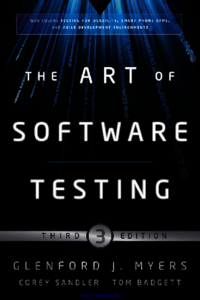
The Art of Software Testing
110 Visitas | 216 Descargas | 2013-09-27 15:42:28 | moliver
The hardware and software of computing have changed markedly in the three decades since the first edition of The Art of Software Testing, but this book's powerful underlying analysis has stood the test of time. Whereas most books on software testing target particular development techniques, languages, or testing methods, The Art of Software Testing, Third Edition provides a brief but powerful and comprehensive presentation of time-proven software testing approaches. If your software development project is mission critical, this book is an investment that will pay for itself with the first bug you find.
The Definitive Guide to NetBeans Platform 7
117 Visitas | 155 Descargas | 2014-01-22 16:21:14 | karelr
Guía definitiva de la plataforma NetBeans en su versión 7. Un recorrido por las principales características de la plataforma.
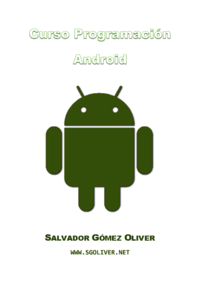
Curso Programacion Android
Programacion para Android
545 Visitas | 871 Descargas | 2014-05-15 02:25:41 | josedanielr
Con el Curso de Programación en Android de sgoliver.net aprenderás a crear desde cero tus propias aplicaciones para dispositivos móviles con sistema operativo Android. Desde los temas más básicos, como descargar e instalar las herramientas necesarias o crear tu primer proyecto paso a paso, hasta temas avanzados como la localización GPS o la comunicación con servicios web. Este manual va dirigido a todas aquellas personas interesadas en un tema tan en auge como la programación de aplicaciones móviles para la plataforma Android. Se tratarán temas dedicados a la construcción de aplicaciones nativas de la plataforma, dejando a un lado por el momento las aplicaciones web. Es por ello por lo que el único requisito indispensable a la hora de utilizar este manual es tener conocimientos bien asentados sobre el lenguaje de programación Java y ciertas nociones sobre aspectos básicos del desarrollo actual como la orientación a objetos.
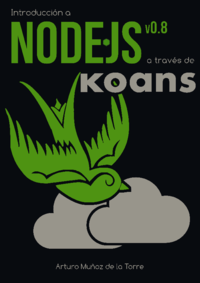
Node.js a travez de Koans
125 Visitas | 161 Descargas | 2014-07-15 15:47:13 | rwpino
Con el presente proyecto se pretenden establecer unas líneas de aprendizaje de la plataforma Node a través de un recorrido interactivo por sus principales módulos, tanto propios como de terceras partes, con el que introducirse y asentar sus principios básicos de funcionamiento. A través de seis capítulos se quiere proporcionar al lector de una amplia visión de qué herramientas pone Node a su disposición y cómo debe usarlas para realizar sus propios desarrollos.
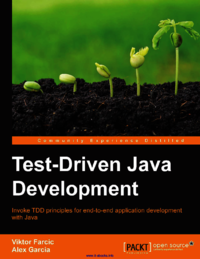
Test-Driven Java Development
Invoke TDD principles for end-to-end application development with Java
109 Visitas | 130 Descargas | 2016-10-05 19:46:05 | josedaniel
This book is written by developers for developers. As such, most of the learning will be through code. Each chapter will present one or more TDD practices and we'll try to master them by solving katas. In karate, kata is an exercise where you repeat a form many times, making little improvements in each. Following the same philosophy, we'll be making small, but significant improvements from one chapter to the next. You'll learn how to design and code better, reduce time-to-market, produce always up-to-date documentation, obtain high code coverage through quality tests, and write clean code that works.
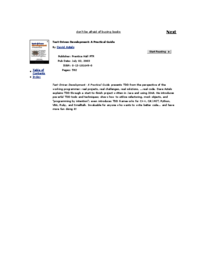
Test-Driven Development: A Practical Guide
48 Visitas | 31 Descargas | 2021-02-03 23:56:42 | wildergd
Test-Driven Development: A Practical Guide presents TDD from the perspective of the working programmer: real projects, real challenges, real solutions, ...real code. Dave Astels explains TDD through a start-to-finish project written in Java and using JUnit. He introduces powerful TDD tools and techniques; shows how to utilize refactoring, mock objects, and "programming by intention"; even introduces TDD frameworks for C++, C#/.NET, Python, VB6, Ruby, and Smalltalk. Invaluable for anyone who wants to write better code... and have more fun doing it!
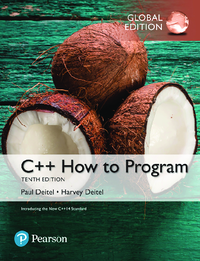
C++ How to program
Programación en C++
90 Visitas | 109 Descargas | 2021-06-16 21:24:16 | josedaniel
We believe that this book and its support materials will give you an informative, challenging and entertaining introduction to C++. The book presents leading-edge computing technologies in a friendly manner appropriate for introductory college course sequences, based on the curriculum recommendations of two key professional organizations— the ACM and the IEEE.
Contribuir
Usted puede contribuir con Libros UCLV, es importante para nosotros su aporte..
Contribuir